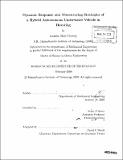Dynamic response and maneuvering strategies of a hybrid autonomous underwater vehicle in hovering
Author(s)
Cooney, Lauren Alise
DownloadFull printable version (24.55Mb)
Other Contributors
Massachusetts Institute of Technology. Dept. of Mechanical Engineering.
Advisor
Franz S. Hover.
Terms of use
Metadata
Show full item recordAbstract
The Odyssey IV autonomous underwater vehicle (AUV) is the next generation of unmanned subsurface robots from the MIT Sea Grant AUV Laboratory. The Odyssey IV AUV has a novel propulsion system, which includes a pair of azimuthing thrusters for maneuvering in surge and heave. An analytical model was developed to describe the complex nonlinear vehicle dynamics, and experiments were performed to refine this model. The fluid dynamics of unsteady azimuthing marine propulsors are largely unstudied, especially for small vehicles like the Odyssey IV AUV. Experiments suggest that thrust developed by an azimuthing propulsor is dependent on the azimuth angle rate of change, and can substantially affect vehicle dynamics. A simple model capturing the effects of azimuthing on the thruster dynamics is developed, and is shown to improve behavior of the model.The use of azimuthing thrusters presents interesting problems and opportunities in maneuvering and control. Nonlinear model predictive control (MPC) is a technique that consists of the real-time optimization of a nonlinear dynamic system model, with the ability to handle constraints and nonlinearities. In this work, several variations of simulated and experimental MPC-based controllers are investigated. The primary challenge in applying nonlinear MPC to the Odyssey IV is solving the time intensive trajectory optimization problem online. Simulations suggest that MPC is able to capitalize on its knowledge of the system, allowing more aggressive trajectories than a traditional PID controller.
Description
Thesis (S.M. in Ocean Engineering)--Massachusetts Institute of Technology, Dept. of Mechanical Engineering, 2009. Includes bibliographical references (p. 87-93).
Date issued
2009Department
Massachusetts Institute of Technology. Department of Mechanical EngineeringPublisher
Massachusetts Institute of Technology
Keywords
Mechanical Engineering.